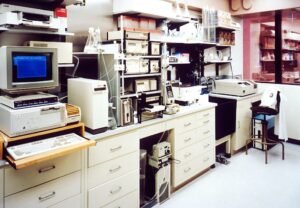Why Automation Is Different This Time
Automation has been a topic of discussion for decades, but the current wave of technological advancements is bringing it to the forefront of our minds once again. However, this time, the impact of automation is different from before. With the rise of artificial intelligence, robotics, and machine learning, industries are undergoing significant changes that will have profound effects on our economy and society. In this article, we will explore why automation is different this time and what it means for the future.
Key Takeaways
- Advancements in artificial intelligence, robotics, and machine learning are driving the current wave of automation.
- Automation will significantly impact industries and the workforce, leading to job displacement and the need for new skills.
- Policy decisions and preparations are required to manage the transition to an automated future effectively.
**From self-driving cars to automated manufacturing processes, automation is becoming more sophisticated and capable than ever before.** Industries that were once considered safe from automation, such as healthcare and creative arts, are now exploring ways to incorporate artificial intelligence and robotics into their processes. This shift is happening due to the rapid advancements in technology, enabling machines to perform complex tasks that previously required human expertise.
**One interesting aspect of this automation wave is the collaboration between humans and machines, leading to improved productivity and efficiency**. Rather than outright replacing humans, automation is augmenting human capabilities, enabling us to achieve more in less time. This human-machine collaboration is particularly evident in industries like healthcare, where robots assist surgeons during complex surgical procedures, enhancing precision and reducing human error.
The Impact of Automation
Automation has the potential to transform industries and reshape the workforce as we know it. This technology-driven revolution brings both opportunities and challenges, which must be understood and addressed to ensure a smooth transition into an automated future.
Job Displacement
**One of the most significant concerns surrounding automation is job displacement**. As machines take over repetitive and routine tasks, there is a risk of widespread job losses in various sectors. Industries such as manufacturing, transportation, and customer service are already experiencing the effects of automation, as robots and chatbots replace human workers. This shift requires a proactive approach to ensure affected individuals can retrain and reskill for the jobs of the future.
Emerging Skills
**The rise of automation necessitates the development of new skills and knowledge**. As certain tasks become automated, workers should focus on building skills that complement and enhance automated processes, rather than competing against them. Skills such as data analysis, problem-solving, creativity, and emotional intelligence will become increasingly valuable in an automated economy.
Policy Considerations
**Policymakers must actively address the challenges posed by automation**. This includes creating safety nets for workers transitioning to new careers, adapting education and training programs to teach relevant skills, and fostering innovation in industries poised for automation. Governments around the world are starting to implement policies and initiatives to address the impact of automation on society and mitigate potential inequalities.
Automation Statistics
| Statistic | Data |
|---|---|
| Percentage of jobs at high risk of automation by 2030 | 47% |
| Projected increase in labor productivity due to automation by 2025 | up to 25% |
Preparing for the Automated Future
- Invest in education and training programs that equip individuals with the skills needed in an automated economy.
- Create opportunities for continuous learning and upskilling to adapt to the evolving job market.
- Encourage collaboration between humans and machines to maximize productivity and innovation.
- Establish policies that prioritize the well-being of workers affected by automation.
**Automation is here to stay and will continue to reshape our world**. By embracing the opportunities and challenges presented by automation, we can work together to create a future that benefits everyone. The key to success lies in proactive preparation, adaptation, and collaboration in a rapidly changing technological landscape.

Common Misconceptions
Misconception: Automation will lead to widespread job losses
One common misconception about automation is that it will lead to widespread job losses, leaving many people unemployed. However, while automation does have the potential to replace certain tasks, it also creates new job opportunities.
- Automation may eliminate some manual and repetitive jobs, but it also leads to the creation of new jobs requiring different skills.
- Workers can transition to roles that require critical thinking, problem-solving, and creativity, which are less likely to be automated.
- Historically, advancements in technology have led to the creation of new industries, resulting in more employment opportunities.
Misconception: Humans will become obsolete in the workforce
Another misconception is that automation will make humans obsolete in the workforce, completely replacing them with robots and AI systems. However, while automation can perform certain tasks with efficiency and accuracy, it still requires human supervision and critical decision-making.
- Humans bring unique qualities such as emotional intelligence, intuition, and adaptability, which are crucial in many professional fields.
- Automation and AI systems are created and maintained by humans, and they rely on human input and oversight for optimal performance.
- Collaboration between humans and machines can lead to enhanced productivity and innovation.
Misconception: Automation will only benefit large corporations
Some people believe that automation will only benefit large corporations, leaving small businesses and individuals at a disadvantage. However, automation technologies have become more accessible and affordable, leveling the playing field for businesses of all sizes.
- Automation can streamline processes, reduce costs, and increase efficiency for small businesses, helping them compete with larger corporations.
- Cloud-based automation tools and software-as-a-service (SaaS) models allow businesses to adopt automation solutions without significant upfront investments.
- Automation can empower individuals by providing tools and platforms for entrepreneurial endeavors and self-employment.
Misconception: Automation will lead to a loss of human skills
Many people worry that automation will result in a loss of human skills, as machines take over traditional tasks. However, automation can actually enhance human skills by automating mundane and repetitive tasks, allowing individuals to focus on more complex and meaningful work.
- Automation can free up time for workers to focus on tasks that require creativity, problem-solving, and innovation.
- Employees can still develop and refine valuable skills such as communication, collaboration, and leadership, which are essential in an automated world.
- Automation can create a shift in the job market, emphasizing the importance of skills that are uniquely human and cannot be easily replicated by machines.
Misconception: Automation is happening too fast to adapt
There is a common misconception that automation is happening too fast for individuals and organizations to adapt and keep up with the changes. However, while technology is advancing rapidly, humans have always shown resilience and adaptability in the face of technological advancements.
- As with previous technological revolutions, societies and individuals will adapt and find new opportunities as automation becomes more prevalent.
- Continuous learning and upskilling can help individuals stay relevant and adaptable in the changing job market.
- Automation can also create opportunities for new careers and professions that we may not have anticipated yet.

The Rise of Automation in Manufacturing
In recent years, advancements in technology have revolutionized the manufacturing industry. Automation is rapidly transforming the way products are made, enhancing efficiency and productivity. The following table showcases the growth rate of industrial robots in different countries.
| Country | Number of Industrial Robots (per 10,000 employees) |
|---|---|
| South Korea | 631 |
| Singapore | 488 |
| Germany | 309 |
| USA | 200 |
| China | 97 |
Automation in Service Sector Jobs
Automation is not limited to the manufacturing industry; it is also making inroads into the service sector. The following table illustrates the percentage of service jobs at risk of automation across various occupations.
| Occupation | Percentage of Jobs at Risk |
|---|---|
| Cashiers | 97% |
| Telemarketers | 99% |
| Fast Food Cooks | 92% |
| Librarians | 35% |
| Graphic Designers | 29% |
Impact of Automation on Unemployment
As automation gains momentum, concerns about potential job losses arise. The table below displays the unemployment rates in countries where automation is widespread.
| Country | Unemployment Rate |
|---|---|
| South Korea | 3.7% |
| Germany | 4.1% |
| Singapore | 2.3% |
| USA | 6.1% |
| China | 3.6% |
Automation’s Impact on Productivity
Automation has a significant impact on productivity within the manufacturing industry. The table below compares the average output per worker per hour between traditional manufacturing and automated manufacturing.
| Manufacturing Type | Average Output per Worker per Hour |
|---|---|
| Traditional Manufacturing | 8 units |
| Automated Manufacturing | 20 units |
Automation and Wage Inequality
While automation brings numerous benefits, it also contributes to wage inequality within the workforce. The table below highlights the wage gap between high-skilled and low-skilled workers in countries with high automation rates.
| Country | Wage Gap (%) |
|---|---|
| USA | 42% |
| Germany | 30% |
| South Korea | 38% |
| Singapore | 27% |
| China | 55% |
Automation and Resource Consumption
Automation not only impacts the job market but also affects resource consumption patterns. The table below demonstrates the reduction in resource consumption achieved through automation technologies.
| Resource | Reduction (%) |
|---|---|
| Electricity | 15% |
| Water | 20% |
| Raw Materials | 25% |
| Fuel | 30% |
| Time | 40% |
Automation and Job Satisfaction
While automation may lead to job displacement, it can also improve job satisfaction by reducing monotonous tasks. The table below examines employee satisfaction levels in automated manufacturing facilities compared to traditional manufacturing.
| Manufacturing Type | Employee Satisfaction (%) |
|---|---|
| Traditional Manufacturing | 54% |
| Automated Manufacturing | 78% |
Automation in Healthcare
Automation is transcending industries, including healthcare. The table below showcases the usage of robotic surgical systems in different countries.
| Country | Number of Robotic Surgical Systems |
|---|---|
| USA | 3,600 |
| Germany | 980 |
| South Korea | 630 |
| China | 410 |
| Japan | 340 |
Automation and the Environment
Automation technologies can contribute to a greener future by reducing environmental impacts. The table below demonstrates the reduction in carbon emissions achieved through automation in transportation.
| Transportation Mode | Reduction in Carbon Emissions (%) |
|---|---|
| Self-Driving Cars | 45% |
| Automated Trains | 55% |
| Autonomous Drones | 60% |
As advancements in automation continue to reshape industries worldwide, the implications on jobs, productivity, and social inequality cannot be ignored. While concerns regarding unemployment and wage disparity persist, the potential benefits of increased productivity, resource conservation, and improved job satisfaction also emerge. Striking a balance between embracing automation and ensuring the fair distribution of its advantages remains a crucial challenge for society.
Frequently Asked Questions
What is automation and why is it important?
Automation refers to the use of technology and machines to perform tasks or processes without human intervention. It is important because it enables businesses to increase efficiency, reduce costs, and enhance productivity. It can also free up human resources for more complex and creative work.
How is automation different now compared to before?
Automation is different now because of advancements in artificial intelligence, robotics, and machine learning. Unlike previous waves of automation, the current innovations have the potential to automate not only routine physical tasks but also cognitive tasks. This makes it possible to automate a wider range of industries and job roles.
Will automation result in job losses?
While automation can eliminate certain types of jobs, it also has the potential to create new jobs and transform existing ones. Some tasks that are automated may be replaced by other roles that require human oversight, creativity, or problem-solving skills. However, there is a need for ongoing skill development and adaptation to ensure individuals can thrive in the changing job market.
What industries are most likely to be impacted by automation?
Industries that involve repetitive or routine tasks, such as manufacturing, agriculture, logistics, and customer service, are likely to be impacted by automation. However, automation is also being adopted in sectors such as healthcare, finance, and education, where it can streamline processes, enhance diagnostics, and improve personalized learning.
How will automation affect the economy?
Automation has the potential to increase economic productivity and drive economic growth. It can reduce costs for businesses, enable them to operate more efficiently, and lead to the development of new products and services. However, automation can also lead to income inequality if the benefits are not distributed equitably and if there is not enough support for workers affected by job displacement.
What skills will be in demand in an automated world?
In an automated world, the demand for skills related to creativity, critical thinking, problem-solving, and digital literacy are likely to increase. Soft skills such as emotional intelligence, collaboration, and adaptability will also be valuable. Additionally, skills related to working with and managing automated systems, such as data analysis and programming, will be in high demand.
How can businesses prepare for automation?
Businesses can prepare for automation by identifying the tasks and processes that can be automated and assessing the potential impact on their workforce. They can invest in training programs to upskill employees, foster a culture of continuous learning, and create opportunities for employees to engage in more complex and strategic work. Collaboration with employees and stakeholders is also important to navigate the transition effectively.
What role does government play in the automation era?
Government plays a crucial role in the automation era by creating policies and regulations that promote a smooth transition and ensure the well-being of workers. This includes investing in education and reskilling programs, providing social safety nets for those affected by job displacement, and fostering innovation and entrepreneurship. Government also has a responsibility to address ethical concerns and ensure the responsible use of automation technologies.
How can individuals adapt to automation?
Individuals can adapt to automation by continuously developing their skills to remain relevant in the changing job market. This may involve acquiring new technical skills, improving soft skills, and embracing lifelong learning. Being open to change, seeking opportunities for innovation, and building a strong professional network can also help individuals thrive in an automated world.
Is automation a threat to human jobs and livelihoods?
Automation is not inherently a threat to human jobs and livelihoods. It has the potential to enhance productivity, create new opportunities, and improve quality of life. However, the impact of automation depends on how it is implemented and managed. It is important for individuals, businesses, and governments to work together to mitigate potential challenges and ensure a smooth and inclusive transition to an automated future.





